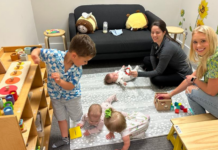 This year I came to the realization that I’ve spent more years of my life dealing with depression than I haven’t. In grade school, I remember writing an essay and likening the absence of depression to warmth, a feeling that one day just went away. Seventeen years later, I have a family of my own and a career but depression is still something I contend with. I wish I could tell my younger self that even though surviving might seem impossible at that very moment, we will go on to experience so many future joys.
This year I came to the realization that I’ve spent more years of my life dealing with depression than I haven’t. In grade school, I remember writing an essay and likening the absence of depression to warmth, a feeling that one day just went away. Seventeen years later, I have a family of my own and a career but depression is still something I contend with. I wish I could tell my younger self that even though surviving might seem impossible at that very moment, we will go on to experience so many future joys.
Now, as a mother myself, I strive to facilitate open, honest, and age appropriate conversations about mental health with my little one. Books are always a wonderful way to start those hard conversations. So I was excited when I discovered The Semicolon by Britt Sayler. This children’s book discusses mental health in a way that I wished I had access to when I was younger. The Semicolon’s concept deeply touched me and I just had to know more about its author Britt Sayler and her inspiration. So, below is a conversation I had with Britt about her fantastic book.

What was your inspiration for writing The Semicolon? Did you draw from your own personal experiences?
The semicolon is often used to tell a story of overcoming struggle, and the choice to keep going when things feel hardest throughout mental health communities. It’s a beautiful symbol of hope and perseverance. I wanted to introduce it to young readers, many of whom will, or are, facing their own struggles with mental health.
I went through my first major depression in my early 20s. It took me to rock bottom and lasted nearly a year. I recovered with the help of counseling, but at its worst, I believed I could never get better. That was more than a decade ago, and what stands out most for me about my recovery was how much I didn’t know – basic concepts like thoughts are not truths, bad feelings won’t last forever, and hope exists even when your mind convinces you otherwise. These are conversations that can start early in life. When I learned about the semicolon symbol, the message resonated with me – and somehow came together in my head as a picture book.
I also live with a mood disorder and an anxiety disorder. A constant in my mental health journey has been difficulty identifying my feelings, let alone communicating them. This can be even harder for kids, who are still developing their self-awareness and emotional vocabulary. For most of The Semicolon, the main character cannot put words together aloud because everything is flying around uncontrollably on the inside.
 Why do you feel an open dialogue about child and teen mental health awareness is so important?
Why do you feel an open dialogue about child and teen mental health awareness is so important?
Mental health challenges can affect anyone, including children. It’s not a sign of personal weakness or a failure of parenting. While not everyone will be diagnosed with a mental disorder or mental illness in their lifetime, virtually everyone will struggle at times to feel okay about themselves or cope with difficult circumstances. So, these conversations are important for general emotional well-being and resilience.
When it comes to mental health conditions like depression, anxiety disorders and other forms of mental illness, unfortunately, these are more common among young people than society cares to admit – and were on the rise even before the pandemic. Many mental health conditions start at a young age and can have lifelong ramifications, which is why beginning these conversations early is important.
For example, children who experience depression are at significant risk of a recurring episode. Some disorders, including depression, even frequently occur together. These can feed into or mask each other but are distinct medical conditions that need to be managed appropriately. Perhaps most importantly, open dialogue matters because these experiences are hard to talk about. They can be painful, confusing and frightening. Depression is especially insidious because it creates feelings of lethargy and apathy. Creating space and trust to figure things out goes a long way to overcome imperfect communication.
 How can The Semicolon assist parents and caregivers with beginning this conversation with young ones?
How can The Semicolon assist parents and caregivers with beginning this conversation with young ones?
The Semicolon is intended to support these conversations, though it’s important to note that the book is not a substitute for professional treatment.
For some background, the book follows a child narrator struggling to cope after the loss of their father. The child’s depression is depicted through the text and artwork but never stated outright. This is intentional to meet readers where they are.
One use for the book is in conversations with youngsters about identifying big feelings, which sometimes show up in subtle ways like bad dreams, stomachaches, or loss of interest in fun activities (all present in The Semicolon). I think its best use is for illustrating that there is hope on the other side of painful experiences, including depression. It’s easy to lose sight of that when we’re at our lowest.
If they’re up for it, adults can use the book to frame some of their own experiences, such as a time they struggled mentally (their equivalent of “the pit”) or, like the main character, couldn’t put feelings into words. Sharing these kinds of experiences helps to reduce stigma and let children know they are not alone.
How can parents purchase your book? Do you have any supplemental resources that are also available?
The Semicolon is available through Amazon, Barnes & Noble , Apple Books, and the FriesenPress bookstore, as well as my website. Patrons can also recommend the book at their local library, which can acquire it through Ingram.
For mental health professionals, I have a reader guide highlighting the different talking points that can be incorporated into counseling sessions. I am currently working with a licensed therapist on a worksheet and set of discussion questions that parents and educators can use with children, which will be online soon as well.














